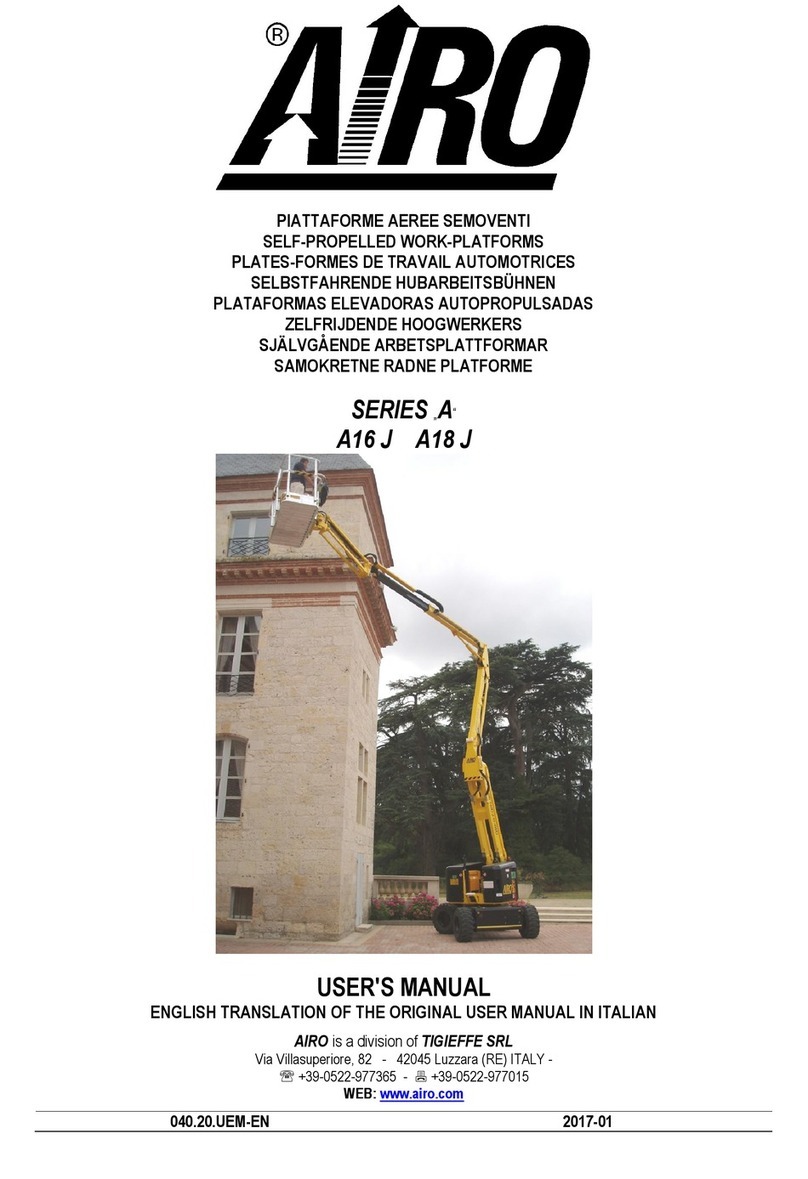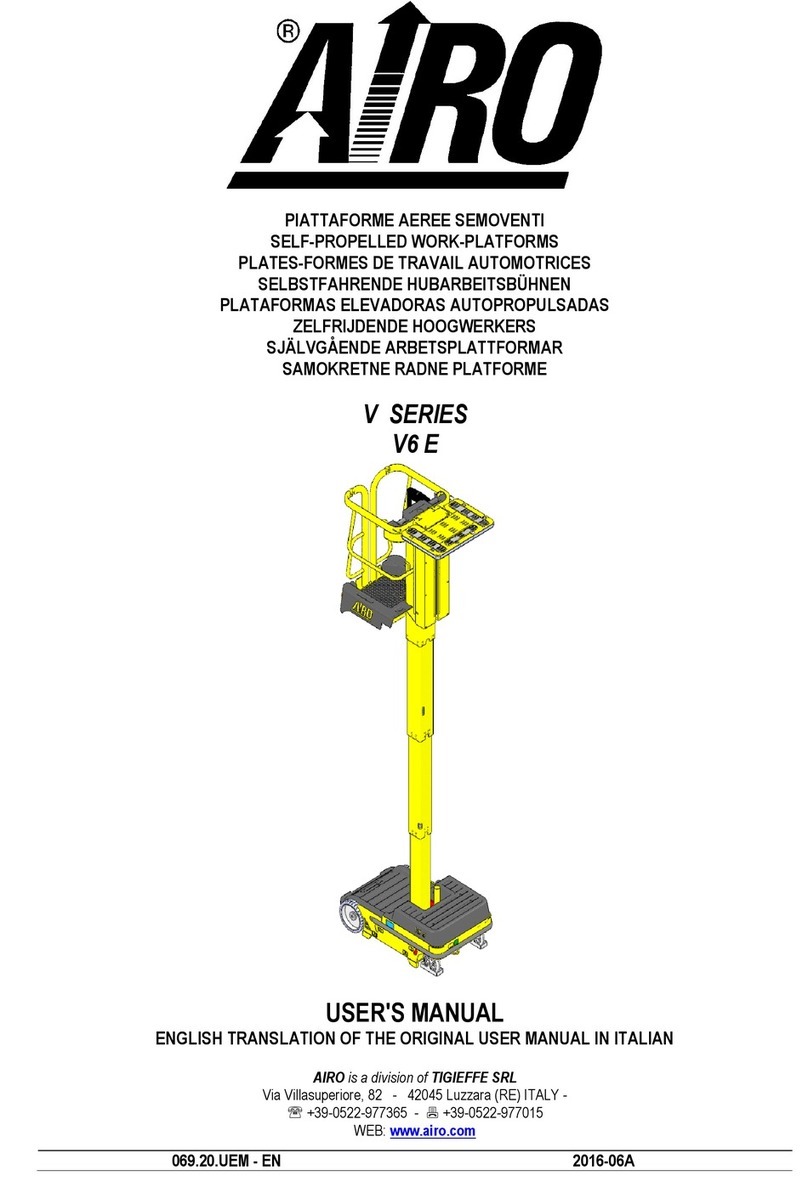
Use and Maintenance Manual - T32 TD T34 JRTD Series
5.1.4. Other functions of the platform control panel..............................................................................................35
5.1.4.1. Work capacity selector ..............................................................................................................................35
5.1.4.2. DIESEL/ELECTRIC drive power selector..................................................................................................35
5.1.4.3. Diesel heat engine start button..................................................................................................................35
5.1.4.4. Emergency electric pump starting switch..................................................................................................35
5.1.4.1. Generator starting switch (OPTIONAL).....................................................................................................35
5.1.4.2. Manual horn ..............................................................................................................................................35
5.1.4.3. Emergency stop button. ...........................................................................................................................36
5.1.4.4. Warning lights............................................................................................................................................36
5.1.4.4.1. Enabled control panel green warning light (ZA) ........................................................................................ 36
5.1.4.4.2. Flat battery red warning light (ZB) –(only active on electric models)........................................................36
5.1.4.4.3. Diesel engine fault / low fuel red warning light (ZC) ..................................................................................36
5.1.4.4.4. Danger red warning light (ZD)................................................................................................................... 37
5.1.4.4.5. Overload red warning light (ZE) ................................................................................................................37
5.1.4.4.6. Extendable axle position green warning light (ZF) ....................................................................................37
5.1.4.4.7. Rotated turret red warning light (ZG).........................................................................................................38
5.1.4.4.8. Tilted platform red warning light (ZH) ........................................................................................................38
5.1.4.4.9. Reached outreach limit red warning light (ZH) ..........................................................................................38
5.2. Ground control panel and electric control unit....................................................................................39
5.2.1. On-off key and control panel selector (A) ...................................................................................................40
5.2.2. Emergency stop button (B).........................................................................................................................40
5.2.3. Diesel heat engine start button (C).............................................................................................................40
5.2.4. User interface display (D) ........................................................................................................................... 40
5.2.5. Powered-on machine warning light (E).......................................................................................................41
5.2.6. Diesel engine warning lights (G H L M) ......................................................................................................41
5.2.7. Platform control levers (N O P Q R S T).....................................................................................................41
5.2.8. ELECTRIC-DIESEL selector (U) ................................................................................................................41
5.2.9. EMERGENCY OVERRIDE emergency recovery enable............................................................................41
5.3. Platform access.......................................................................................................................................42
5.4. Machine start-up......................................................................................................................................42
5.4.1. Diesel engine start-up.................................................................................................................................43
5.5. Machine stop ...........................................................................................................................................43
5.5.1. Normal stop ................................................................................................................................................43
5.5.2. Emergency stop button............................................................................................................................... 43
5.5.3. Diesel engine stop......................................................................................................................................44
5.6. Emergency manual controls ..................................................................................................................45
5.6.1. Emergency manual control: Use of the ground control panel.....................................................................45
5.6.2. Emergency manual control: Emergency electric pump...............................................................................45
5.6.3. Emergency manual control: EMERGENCY OVERRIDE ............................................................................46
5.7. Socket for electric tool connection (Optional)......................................................................................47
5.7.1. 230v power line (OPTIONAL).....................................................................................................................47
5.7.2. Hydraulic generator (OPTIONAL)...............................................................................................................47
5.8. Fuel level and re-fuelling (models “ED”, “D”).......................................................................................48
5.9. End of work..............................................................................................................................................48
6. HANDLING AND CARRYING.....................................................................................................49
6.1. Handling...................................................................................................................................................49
6.2. Carrying....................................................................................................................................................51
6.3. Emergency towing of the machine........................................................................................................53
7. MAINTENANCE..........................................................................................................................54
7.1. Machine cleaning ....................................................................................................................................54
7.2. General maintenance..............................................................................................................................55
7.2.1. Various adjustments...................................................................................................................................57
7.2.2. Greasing.....................................................................................................................................................58
7.2.3. Hydraulic circuit oil level check and change ...............................................................................................59
7.2.3.1 Biodegradable hydraulic oil (Optional).......................................................................................................61
7.2.3.2 Emptying ...................................................................................................................................................61
7.2.3.3 Filters ........................................................................................................................................................61
7.2.3.4 Washing ....................................................................................................................................................61





























